It is also called bearcat yet it is neither a bear or a cat, it is a binturong! It is a mammal of the family of the Viverridae, just like the civet or the genet of Europe. Its most characteristic features are its long hairy ears, its imposing coat, its prehensile tail and its popcorn smell.What does “prehensile” mean? Why the popcorn? Go down to find out.
HOME > THE BINTURONG
Scientific name
Arctictis binturong
Distribution / Habitat
South-East Asia in the large tropical forests that have been less degraded by humans
Population
Unknown to date
Size (muzzle to tail)
From 120 cm to 180 cm
Weight
From 9 kg to 24 kg
Diet
Omnivorous. 80% fruit. Small animals.
Status
Vulnerable (IUCN 2016)
An adult binturong measures between 60 and 90 cm (without the tail). It can weigh between 9 and 24 kg.
The color of its coat varies from dark to light gray, and can be tinged with brown. Its ears are round, edged in white and end in a lynx-like tuft of hair. Its eyes are chocolate brown. It has powerful front paws and long claws that enable it to climb trees and move around branches with ease. To keep its balance, it can also use its prehensile tail. This means it can pick things up with it, and uses it to hold on to branches to avoid falling. An adult binturong measures between 60 and 90cm, with a tail that can reach 90cm.8. Its weight can vary from 9 to 24 kg6.
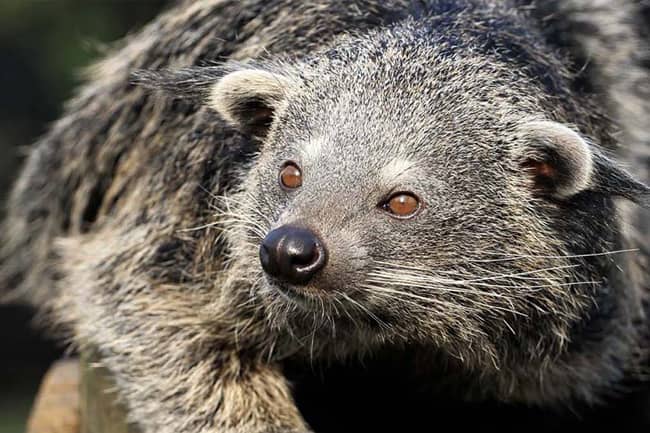
Credit Emmanuel Baril

Credit E. Maizeray
It has a popcorn smell produced by its anal glands.
It has the particularity of smelling like popcorn. This is due to a compound in its urine that enables it to communicate with other individuals of its species, giving information such as its sex and reproductive status3 with other individuals of its species.
It is arboreal, which means that it spends most of its life in trees. However, it has already been observed on the ground, especially when there are holes in the canopy9&12. It is mainly nocturnal2but studies have reported cases of daytime activity12.
The binturong lives in Southeast Asia in large tropical forests, little degraded by humans.
The binturong is a mammal that lives in primary (very little degraded by humans) and secondary (little degraded) forests of Southeast Asia.
It can be seen in Bangladesh, Bhutan, Cambodia, China, India, Vietnam, Laos, Thailand, Indonesia (on the island of Java, Kalimantan, Borneo, and Sumatra), Malaysia (on the island of Sarawak, Sabah (Borneo) and the Malay peninsula), Myanmar, Nepal and the Philippines (only on Palawan)11.
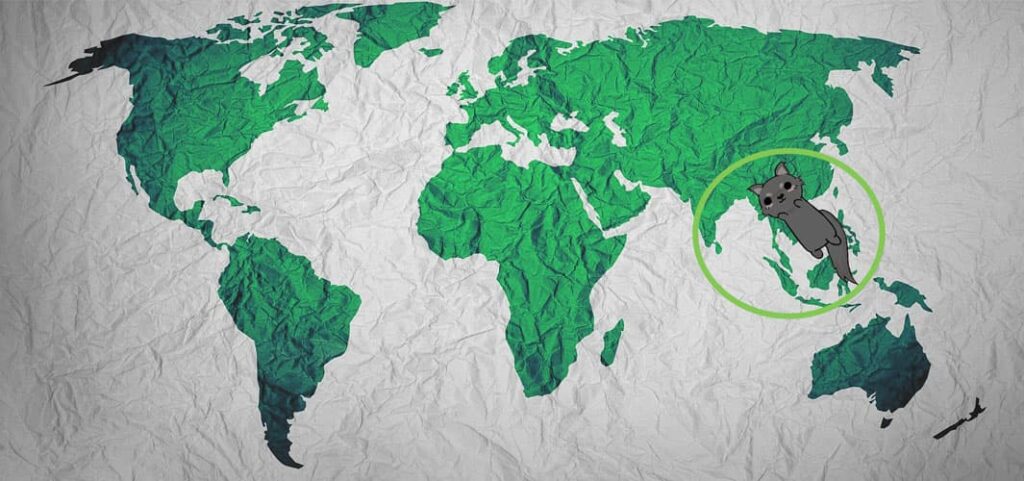
Its diet consists of 80% of fruit.
Even if it is part of the order of carnivores because of its dentition, its diet is not carnivorous, but omnivorous. It can feed on rodents and birds, but the majority of its diet is fruit. He is particularly fond of figs from trees of the genus Ficus7&10. In a way, it's one of the most frugivorous carnivores.10.
When it eats fruit, it gobbles it whole, including the seeds or pits. Digested seeds and pits germinate faster1 and are scattered throughout the forest according to the movements of the binturong. Everything suggests that it has an important role in the regeneration of the forest.

Figs - Image by Drago Gazdik from Pixabay
There may be 1 to 6 small binturongs per litter.
Binturong can reproduce all year round. After a gestation period of 3 months, the female gives birth to a litter of 1 to 6 small binturongs. They are born blind and are breastfed by their mother for more than 3 months. 25 days after birth, their teeth begin to grow and from their 45th day, they can eat solid food (fruit, meat, etc.).
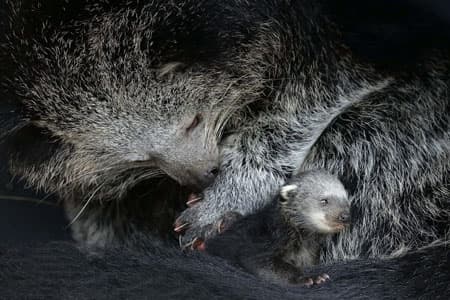
Binturong baby -Credit: E.Baril
It is mainly threatened by deforestation and the illegal trade in wild species for sale as pets or for the resale of its fur and meat.11. This is why it is classified as Vulnerable on the IUCN (International Union for Conservation of Nature) Red List.11.

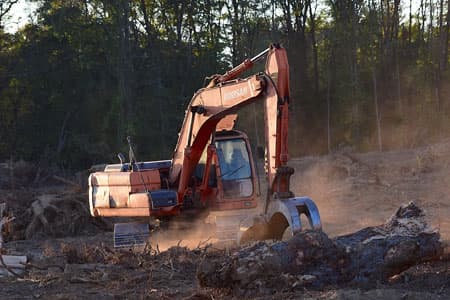
Deforestation - Image by Edo Emmerig from Pixabay
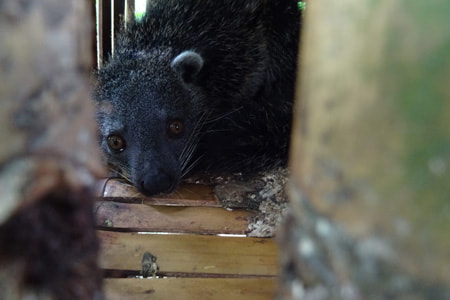
Binturong trapped - Langogan, Palawan Island, Philippines. Credit P. Kayser
Several zoos around the world are involved in the conservation of binturong as part of breeding programmes as is the case in Europe with the European breeding program of endangered species (also called EEP) created by EAZA ((European Association of Zoos and Aquaria).
Have you fallen in love with binturong and would like to help us? Make a donation!
These donations are invaluable for the realisation of our various programmes in France and abroad. For more information on our projects, visit our project page.
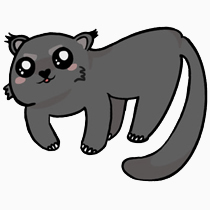
Credit E. Maizeray
1 Colon C.P, Campos-Arceiz A., 2013, The impact of gut passage by binturongs (Arctictis binturong) on seed germination, The Raffles Bulletin of Zoology, 61, 417-421
2 Grassman Jr. L.I., Tewes M.E., Silvy N.J., 2005, Ranging, habitat use and activity patterns of binturong Arctictis binturong and Yellow-throated marten Martes flavigula in north-central Thailand, Wildlife Biology, 11, 49-57, https://doi.org/10.2981/0909-6396(2005)11[49:RHUAAP]2.0.CO;2
3 Green L.K., Wallen T.W., Moresco A., Goodwin T.E., Drea C.M., 2016, Reproductive endocrive atterns and volatile urinary compounds of Arctictis biturongdiscovering why bearcats smell like popcorn, The Science of Nature, https://doi.org/10.1007/s00114-016-1361-4
4 Lam W.Y, Hedges L., Clements G.R, 2014, First record of a clouded leopard predating on a binturong, Catnews, 60, 33
5 Lambert J.E., Fellner V., McKenney E., Hartstone-Rose A., 2014, Binturong (Arctictis binturong) and Kinkajou (Potos flavus) digestive strategy: Implication for interpreting Frugivory in Carnivora and Primates, PLuS ONE, https://doi.org/10.1371/journal.pone.0105415
6 Moresco A., and Larsen R.S., 2003, Medetomidine-ketamine-butorphanol anesthetic combinations in binturongs (Arctictis binturong), Journal Zoo Wildlife Medicine Off. Publ. Am. Assoc. Zoo Vet. 34, 346-351.
7Nakabayashi M., Ahmad A.H., Kohshima S., 2014, Fruit selection of a binturong (Arctictis binturong) by focal animal sampling in Sabah, Malaysian Borneo, Mammalia, https://doi.org/10.1515/mammalia-2015-0009
8 Pocock R.I.,1933, The rarer Genera of Oriental Viverridæ, Proc. Zool. Soc. Lond. 103, 1016-1031
9 Semiadi G. et al2016, Predicted distribution of the binturong Arctictis binturong (Mammalia: Carnivora: Viverridae) on Borneo, The Raffles Bulletin of Zoology, 33, 96-102
10 Shanahan, M., 2000. Ficus Seed Dispersal Guilds: Ecology, Evolution and Conservation Implications. Unpublished PhD thesis, University of Leeds, UK. 210 pp.Shanahan, M., S. So, S. G. Compton & R. Corlett, 2001. Fig-eating by vertebrate frugivores: A global review. Biological Reviews of the Cambridge Philosophical Society, 76: 529-572.
11 Willcox D.H.A., Chutipong W., Gray T.N.E., Cheyne S., Semiadi G., Rahman H., Coudrat C.N.Z., Jennings A., Ghimirey Y., Ross J., Fredriksson G. & Tilker A. 2016. Arctictis binturong. The IUCN Red List of Threatened Species 2016: e.T41690A45217088. http://dx.doi.org/10.2305/IUCN.UK.2016-1.RLTS.T41690A45217088.en. Downloaded on 25 November 2019.
12 Zaw T., Htun S., Po S.H.T, Maung M., Lynam A.J, Latt K.T, Duckworth J.W, 2008, Status and distribution of small carnivores in Myanmar, Small Carnivore Conservation, 38, 2-28